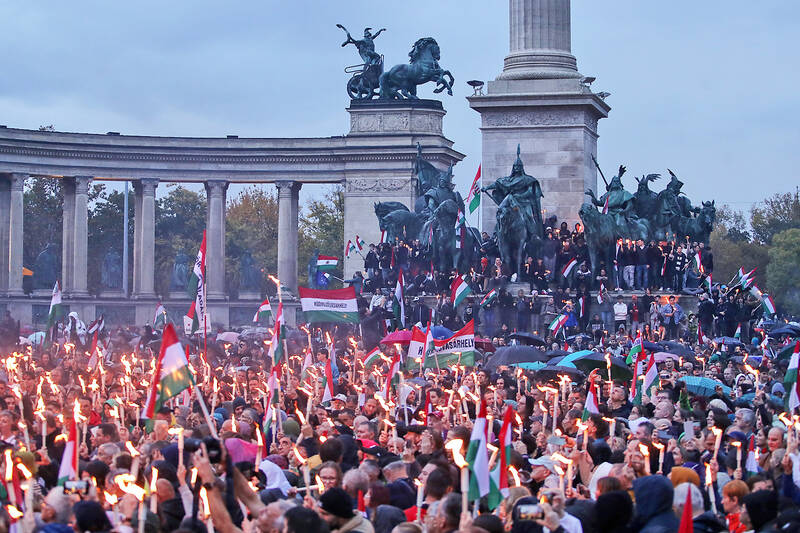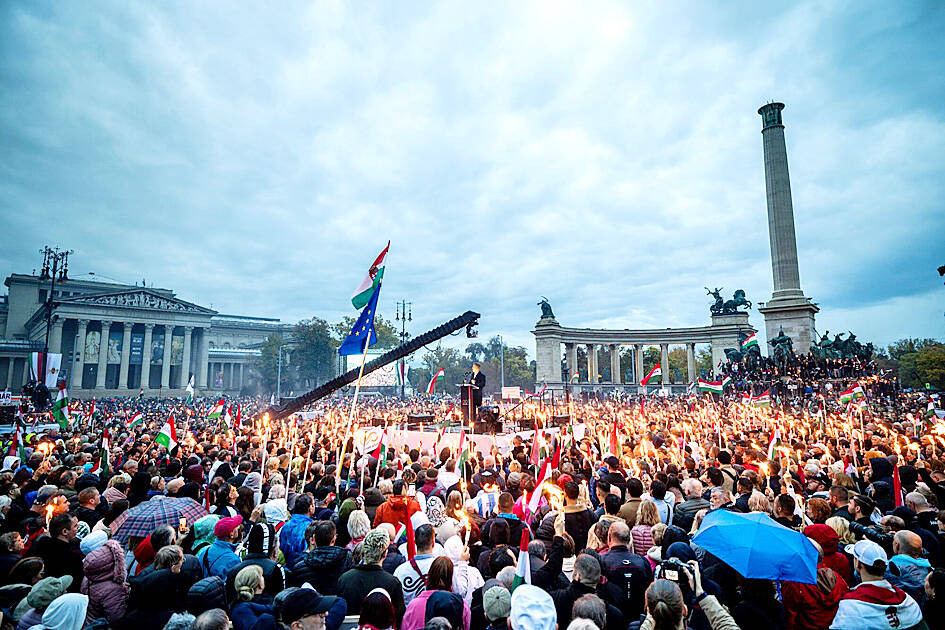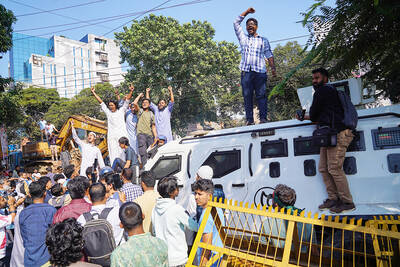Hundreds of thousands of Hungarians filled the streets of Budapest on Thursday in competing demonstrations as supporters of the country’s two main political movements staged mutual shows of strength before next spring’s national election.
The rival rallies were a standoff between Hungarian Prime Minister Viktor Orban and his main political challenger, Peter Magyar, who looks set to present the long-serving Hungarian leader with the most competitive ballot in his 15 years in power.
The election is due in April, but an exact date for the vote has not been set.

Photo: AP
Orban’s supporters gathered on a bridge spanning the Danube River on Thursday morning and began marching toward Hungary’s towering neo-Gothic parliament. The rally, dubbed a “peace march” by organizers, came on Hungary’s Oct. 23 national holiday, a remembrance of a failed anti-Soviet uprising in 1956 that was crushed by the Red Army.
Participants shouted slogans backing Orban, and his message that foreign powers threaten to push Hungary into direct involvement in Russia’s war in Ukraine. At the front of the march, one large banner read: “We don’t want to die for Ukraine.”
Addressing the crowd in a speech riddled with hostility for Ukraine and the EU — regular subjects of his ire — Orban said Kyiv’s European backers had brought the EU into the war, and of being willing “to send others to die.”

Photo: Bloomberg
During his 40-minute speech, Orban said that Ukraine “has long ceased to be sovereign, independent and is absolutely not self-sufficient.”
He said he would support a strategic partnership between the EU and Kyiv, but that Ukraine “cannot be members either of our military or economic alliance. They would bring war, take our money and ruin our economy.”
Later in the day, throngs of supporters of opposition leader Magyar filled one of Budapest’s central squares and adjacent avenues for their own demonstration — an anti-government protest and a show of support for Magyar and his center-right Tisza party.
Marchers shouted anti-government slogans, as well as “Russians go home” — a refrain from Hungary’s 1956 anti-Soviet rebellion and a modern reference to many people’s view that Orban has drawn the country too close to Moscow.
One Tisza supporter, Zsanett Kiss, traveled from Papa in western Hungary to attend the march. She said she believed Magyar would be able to improve Hungary’s stagnant economy and bring the country back to a more democratic path.
“I want there to be a change already in this country, and I can say that I’ve had enough, enough of the last 15 years,” she said.
Magyar, a 44-year-old lawyer and former insider within Orban’s Fidesz party, burst into political prominence last year, and has focused his message on bread-and-butter issues affecting the majority of Hungarians: persistent inflation, poor health care and increasingly salient allegations of government corruption — all sources of dissatisfaction that have plagued Orban’s government.
Magyar has focused his campaign on the rural countryside, traditionally a reliable voting bloc for Fidesz. He recently ended an 80-day tour of the country where he held scores of town hall-style forums, giving speeches and taking questions from attendees.
Speaking to the crowd of his supporters that filled Budapest’s sprawling Heroes’ Square, Magyar said Orban had impoverished the country by misusing public funds and turning Hungarians against one another.
However, he also struck an inclusionary tone, encouraging his supporters to embrace their political opponents following next April’s election.
“I call on everyone to stick together and endure these six bitter months, and then to reach out to those who gathered at another event today,” Magyar said.
He encouraged the crowd to imagine a future in which, “on Oct. 23 of next year, there are not two contemptuous crowds facing each other, but a nation united, celebrating and smiling at each other.”
The dueling marches on Thursday were seen as a barometer of which politician had more energy behind his campaign as the election nears. Orban is lagging in the polls behind Magyar’s Tisza, and with six months before the ballot, the prime minister has struggled to reinvigorate his base.
Still, the EU’s longest-serving leader remains popular among a sizable portion of Hungary’s voters, and on Thursday was able to successfully mobilize many thousands to Budapest in his support.
Scores of buses that were used to transport participants from around Hungary and neighboring countries were parked near the pro-government march route. One marcher, Sandor Kerekes, said that he had come to the event from the ethnic Hungarian-majority town of Fantanele, in Romania’s Transylvania region.
“It’s important for us to feel like we can meet with like-minded people, that we think the same things and think with unity,” he said.

DISASTER: The Bangladesh Meteorological Department recorded a magnitude 5.7 and tremors reached as far as Kolkata, India, more than 300km away from the epicenter A powerful earthquake struck Bangladesh yesterday outside the crowded capital, Dhaka, killing at least five people and injuring about a hundred, the government said. The magnitude 5.5 quake struck at 10:38am near Narsingdi, Bangladesh, about 33km from Dhaka, the US Geological Survey (USGS) said. The earthquake sparked fear and chaos with many in the Muslim-majority nation of 170 million people at home on their day off. AFP reporters in Dhaka said they saw people weeping in the streets while others appeared shocked. Bangladesh Interim Leader Muhammad Yunus expressed his “deep shock and sorrow over the news of casualties in various districts.” At least five people,

LEFT AND RIGHT: Battling anti-incumbent, anticommunist sentiment, Jeanette Jara had a precarious lead over far-right Jose Antonio Kast as they look to the Dec. 14 run Leftist candidate Jeannette Jara and far-right leader Jose Antonio Kast are to go head-to-head in Chile’s presidential runoff after topping Sunday’s first round of voting in an election dominated by fears of violent crime. With 99 percent of the results counted, Jara, a 51-year-old communist running on behalf of an eight-party coalition, won 26.85 percent, compared with 23.93 percent for Kast, the Servel electoral service said. The election was dominated by deep concern over a surge in murders, kidnappings and extortion widely blamed on foreign crime gangs. Kast, 59, has vowed to build walls, fences and trenches along Chile’s border with Bolivia to

DEATH SENTENCE: The ousted leader said she was willing to attend a fresh trial outside Bangladesh where the ruling would not be a ‘foregone conclusion’ Bangladesh’s fugitive former prime minister Sheikh Hasina yesterday called the guilty verdict and death sentence in her crimes against humanity trial “biased and politically motivated.” Hasina, 78, defied court orders that she return from India to attend her trial about whether she ordered a deadly crackdown against the student-led uprising that ousted her. She was found guilty and sentenced to death earlier yesterday. “The verdicts announced against me have been made by a rigged tribunal established and presided over by an unelected government with no democratic mandate,” Hasina said in a statement issued from hiding in India. “They are biased and politically motivated,” she

It is one of the world’s most famous unsolved codes whose answer could sell for a fortune — but two US friends say they have already found the secret hidden by Kryptos. The S-shaped copper sculpture has baffled cryptography enthusiasts since its 1990 installation on the grounds of the CIA headquarters in Virginia, with three of its four messages deciphered so far. Yet K4, the final passage, has kept codebreakers scratching their heads. Sculptor Jim Sanborn, 80, has been so overwhelmed by guesses that he started charging US$50 for each response. Sanborn in August announced he would auction the 97-character solution to K4